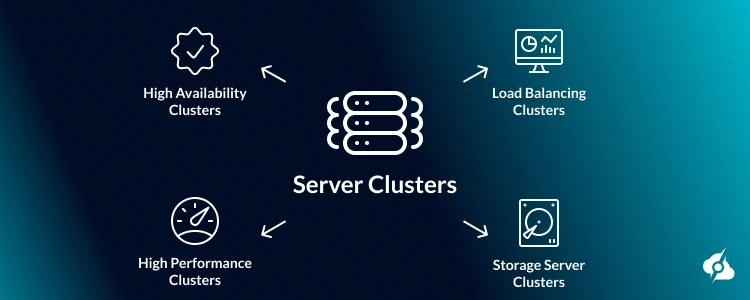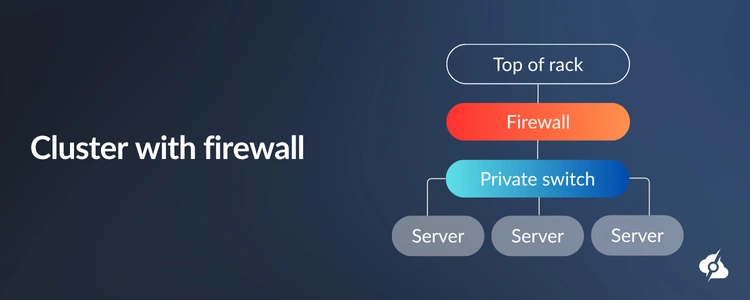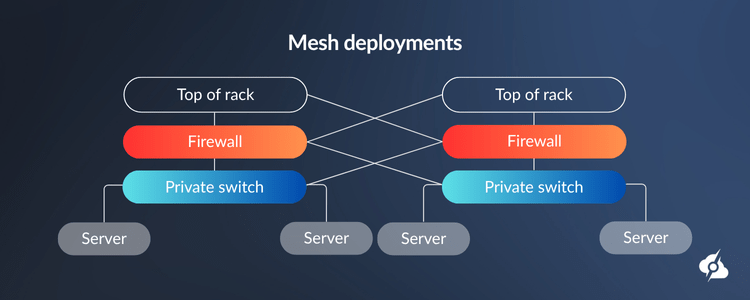What is a Server Cluster?

As demand for greater performance continues to rise across businesses and data centers, server clusters have become an essential solution.
A clustered server guarantees fault tolerance, load balancing, and high availability by combining two or more servers or multiple nodes. Clusters are built for reliability. They share the workload, whether that’s web hosting, data storage, or heavy computations. So if one server fails, the other keeps everything running.
ServerMania, a leader in dedicated hosting, offers server cluster hosting solutions and dedicated servers for clustering to help businesses implement the perfect server cluster. We offer services from database clustering to colocation for server clusters, verifying that application users and IT teams can optimize resource utilization and maximize computing power.
How Server Clustering Works
A server cluster is a group of servers working together under a single IP address to provide users with higher availability, scalability, and reliability. Since server clusters are a group of servers connected to a single system, they work together to increase efficiency.
For instance, whenever one of the servers experiences a service outage, server clusters allow another server to take up the operation, distributing the workload to another server before the user experiences an outage or downtime. In its essence, a server clusters help users reduce downtime and improve the efficiency of operation rather than shutting down.
In a clustered server environment, each server in a cluster is called a node. However, each node has its own RAM, hard drive, operating system, and CPU resources to command.
They are responsible for managing and owning their components, which means that work can easily be transferred to another server when one server within the cluster fails. Users can easily access server-related resources since their work is uninterrupted.
How Server Clusters Handle Failures
Before diving into clustering, it’s important to understand how it helps protect against outages. Server clusters are designed to maintain uptime and reliability when unexpected issues occur.
Outages can result from software errors, physical damage to the hardware, or external events at the data center. Clusters are built to handle these situations effectively, including:
Application/Service Failures: Clustering servers can deal with application or service failures resulting from critical errors involving software or services that are crucial to the operation of the server or data center. However, the app or service failures are also caused by other factors, and they are unavoidable.
Hardware/System Failures: A server cluster also helps to deal with hardware failures that can affect the smooth running of your services. Hardware/system failures are caused by overheating, poor optimization, or the component reaching the end of its product lifespan. Hardware components affected in this process are CPUs, memory, power supplies, and hard drives.
Website/Hosting Failures: We all know how widespread site failures are. So, server clusters help deal with site-related problems caused by events outside the data center environment, such as natural disasters, power disruptions, and many more potential issues.
Clustering: Technical Deep Dive
A server cluster is dependent on multiple individual servers, also called “nodes,” that work together to deliver reliable redundancy. The clustering servers typically coordinate the computing resources across these nodes, managing active nodes and distributing incoming requests.
The nodes themselves communicate through the network infrastructure and share their primary storage through storage servers or (in some cases) disk arrays. This cluster configuration, paired with efficient cluster management software, is the ideal way for load balancing.
On the other hand, we also have data synchronization and heartbeat monitoring, which are absolutely critical for fault tolerance and the high availability expected from clustering. Mostly, individual nodes perform complex computations while sharing hardware resources to achieve even resource utilization.
Here are the primary aspects of a clustering server:
| Component | Role |
|---|---|
| Nodes | Individual servers that execute tasks and share computing resources. |
| Shared Storage | SAN/NAS configurations that provide centralized storage capacity for all nodes. |
| Cluster Management Software | Coordinates cluster configuration, failover mechanisms, and heartbeat monitoring. |
| Network Infrastructure | High-speed interconnects enable data synchronization and node communication. |
| Load Balancers | Distribute incoming requests to active nodes, optimizing resource utilization. |
Explore: Enterprise Clustering Solutions
Server Clusters: Infrastructure-Level Classification
Cluster servers are primarily classified based on their node or clustering system, fused with the device responsible for storing configuration data.
There are three different types of server clusters:
1. Single Quorum Cluster
A single or standard quorum cluster is one of the most commonly used server clusters. It consists of multiple servers that employ one or more cluster disk arrays for a single connection device known as a bus. In essence, the server is responsible for managing and owning the individual cluster disk arrays within the cluster. The titular quorum is the system used in determining whether or not each cluster is online and uncompromised.
Single or standard quorum clusters are efficient and straightforward to use. Each server has a vote to communicate with the central bus online.
2. Majority Node Set Cluster
The majority node set cluster is similar to single quorum clusters. However, with the majority node set cluster, there is more flexibility when it comes to configuring remote servers. It works for servers that are located in different geo-locations.
So, each node has its own copy of the cluster’s configuration data, which consistently flows across all nodes. However, most node set clusters do not need a shared storage bus to function, as each node has its own storage system for duplicate quorum data locally.
3. Single Node Cluster
The single-node cluster contains a single node, mainly used for testing. Since single-node clusters are mainly used for testing purposes, they are best used as a tool for research and development of cluster applications. However, the use of a single-node cluster is limited by its lack of failover since it’s made with a single node, which can cause the unavailability of cluster groups.
See Also: What is High Performance Computing (HPC)?
Types of Server Clusters

Modern server clusters are designed to meet different performance, availability, and scalability needs by organizations with varying goals. So, depending on how various servers share resources and recover from failures, each cluster type offers a unique balance.
Here are the four main types of server clusters by their modern functionality:
High Availability Clusters
The high-performance cluster is built for continuous uptime. HA clustering utilizes the so-called active-passive configuration, where one node remains on standby to take over if another fails.
These systems are commonly referred to as the foundation of any critical services, minimizing single points of failure. They commonly rely on a tightly coupled architecture that keeps data synchronized in small blocks, ensuring uninterrupted access for users even during maintenance or any failover events.
Load Balancing Clusters
The load balancing clusters are designed to handle large volumes of data, such as handling the traffic of real-time streaming or web hosting.
The load-balancing clusters focus on distributing workloads evenly across two nodes or even several servers. This structure uses a loosely coupled architecture, where two or more servers share requests independently while maintaining overall stability.
The bottom line here is that it’s a cost-effective method for scaling performance and reducing latency, ideal for websites, e-commerce, and application users expecting fast response times.
High Performance Clusters
An HPC cluster brings together multiple nodes to perform computational tasks that demand immense computing resources. Using a customizable infrastructure, administrators can pair the same type of machines or blend different ones to process scientific simulations.
In this setup, each node contributes to parallel processing power, forming a single, efficient computing environment capable of handling the most demanding workloads.
Storage Server Clusters
Storage servers in this model work together to store data securely and provide instant redundancy. By combining hardware resources across nodes, these clusters ensure reliability for backups, analytics, and large-scale data systems.
The design supports elasticity and stability, giving organizations an adaptable foundation for long-term storage growth and performance consistency.
See Also: What is a Kubernetes Cluster?
Setting Up a Server Cluster
When setting up a server cluster, you first need to carefully plan the correct hardware pieces as well as the right software that will verify high availability, redundancy, and reliability. It doesn’t matter whether you’re going for active active cluster for performance or a small setup for data processing, there are three key phases that you would need to go through:
1. Planning Phase
To begin, you’ll need to evaluate your workload requirements and try to determine the perfect cluster size for your projects. That means deciding how many different nodes are needed, what server type you’ll need, and how much budget you are willing to allocate.
This is the phase that helps users identify where user requests will originate and how to route them for maximum uptime. It also determines the type of your server.
2. Hardware Setup
Once planned, provisioning begins with setting up managed servers, configuring networking, and preparing redundant hardware for failover protection.
Each dedicated server or single server in the cluster must be optimized for stability, ensuring that if any server fails, the remaining nodes continue operating. Proper node storing and physical arrangement help improve scalability and airflow in your environment.
3. Software Configuration
The final step is, of course, the operating system where you’ll be deploying your clustering software and then setting up the app for synchronization. So, based on your setup, an active-active configuration can easily enhance
The final stage involves installing the operating system, deploying clustering software, and setting up applications for synchronization. Depending on your setup, an active-active configuration can enhance performance by allowing all nodes to process data simultaneously.
➡️ Here at ServerMania, we help you with the deployment of your cluster, either through guidance or via our managed services for complete handling.
See Also: How to Set Up a MongoDB Cluster
Common Use Cases and Applications
A server cluster allows businesses to scale efficiently, enhance reliability, and maintain performance when one server or node fails. So, by distributing workloads across multiple systems, such a cluster provides the foundation for modern infrastructure.
See Also: How to Optimize a Server for Big Data Analytics
Here are some examples:
| Purpose & Benefits | Example Use Case | |
|---|---|---|
| E-commerce Platforms | Handle heavy traffic spikes with high availability clusters for checkout and payment reliability | Large online retailers use clustering to keep carts and sessions active during peak hours |
| Database Clustering | Improve storage consistency and query performance across multiple nodes | Supports analytics, data warehousing, and replication for consistent uptime |
| Web Hosting | Boost stability in dedicated server and shared environments through seamless load balancing | Ensures faster website delivery and consistent performance globally |
| Enterprise Applications | Protect critical business tools such as ERP, CRM, and communication systems | Maintains service continuity when a node fails, reducing downtime and data loss |
Cluster Hosting Solutions
Our clustered hosting solutions are designed for scalability, redundancy, and uninterrupted performance.
Each deployment type offers different levels of isolation, control, and fault tolerance. This is ideal for businesses with mission-critical workloads or high availability requirements.

Private Switch
A dedicated environment that connects multiple servers through a private network. Perfect for businesses that need enhanced data privacy, fast internal communication, and full control over their network configuration.

Cluster with Firewall
Adds a dedicated firewall layer for improved network protection and traffic management. Ideal for organizations running sensitive applications or customer-facing platforms that require enhanced security and uptime.

Mesh Deployment
A fully integrated setup offering advanced redundancy, load balancing, and seamless failover between nodes. Designed for large-scale or enterprise workloads that demand continuous availability and performance consistency.
Deploy Your Server Cluster with ServerMania

If you are ready to build a powerful, scalable server cluster for your business, here at ServerMania, we provide an infrastructure crafted to last. Our high-availability clusters are built to eliminate downtime, guarantee redundancy, and support your project with any specific requirements.
Every dedicated server in our network is optimized for high performance, delivering consistent speed and reliability under heavy workloads. With high-availability architecture and proactive management, ServerMania makes scaling and maintaining the clustered environment easy, secure, and future-ready.
Here are some places to begin:
💬 To learn more about active server cluster hosting and dedicated servers, contact us at ServerMania, and we’ll help you select the appropriate systems for your application.
Was this page helpful?

